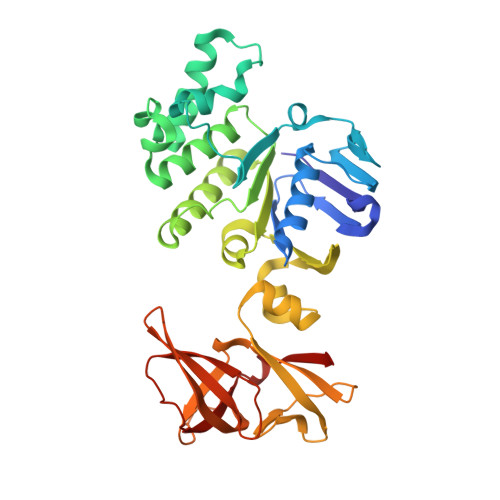Formation of the productive ATP-Mg2+-bound dimer of GlcV, an ABC-ATPase from Sulfolobus solfataricus
Verdon, G., Albers, S.-V., van Oosterwijk, N., Dijkstra, B.W., Driessen, A.J.M., Thunnissen, A.M.W.H.(2003) J Mol Biology 334: 255-267
- PubMed: 14607117
- DOI: https://doi.org/10.1016/j.jmb.2003.08.065
- Primary Citation of Related Structures:
1OXX - PubMed Abstract:
The ABC-ATPase GlcV from Sulfolobus solfataricus energizes an ABC transporter mediating glucose uptake. In ABC transporters, two ABC-ATPases are believed to form a head-to-tail dimer, with both monomers contributing conserved residues to each of the two productive active sites. In contrast, isolated GlcV, although active, behaves apparently as a monomer in the presence of ATP-Mg(2+), AMPPNP-Mg(2+) or ATP alone. To resolve the oligomeric state of the active form of GlcV, we analysed the effects of changing the putative catalytic base, residue E166, into glutamine or alanine. Both mutants are, to different extents, defective in ATP hydrolysis, and gel-filtration experiments revealed their dimerization in the presence of ATP-Mg(2+). Mutant E166Q forms dimers also in the presence of ATP alone, without Mg(2+), whereas dimerization of mutant E166A requires both ATP and Mg(2+). These results confirm earlier reports for other ABC-ATPases, but for the first time suggest the occurrence of a fast equilibrium between ATP-bound monomers and ATP-bound dimers. We further mutated two highly conserved residues of the ABC signature motif, S142 and G144, into alanine. The G144A mutant is completely inactive and fails to dimerize, indicating an essential role of this residue in stabilizing the productive dimeric state. Mutant S142A retained considerable activity, and was able to dimerize, thus implying that the interaction of the serine with ATP is not essential for dimerization and catalysis. Furthermore, although the E166A and G144A mutants each alone are inactive, they produce an active heterodimer, showing that disruption of one active site can be tolerated. Our data suggest that ABC-ATPases with partially degenerated catalytic machineries, as they occur in vivo, can still form productive dimers to drive transport.
- Laboratory of Biophysical Chemistry, Groningen Biomolecular Sciences and Biotechnology Institute, University of Groningen, Nijenborgh 4, 9747 AG Groningen, The Netherlands.
Organizational Affiliation:

















